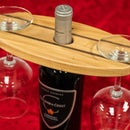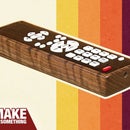Introduction: Make a Guitar With CNC
Step by step instructions on how to make a solid body guitar on the CNC using parts from a cheap Epiphone Les Paul. I purchased my Epiphone Les Paul online for only $120 just to gut it for the electronics, hardware and neck. I used some 8/4 ash for the body and carved out the neck pocket, pickup and electronics cavities on the X-Carve CNC. With an angle grinder and TurboPlane blade I did some final shaping. The pick guard, headstock laminate and truss rod cover was also cut out on the X-Carve CNC using carbide bits from ToolsToday. I'm very please with this guitar build and plan on filming a follow-up video answering your questions as well as discuss what I'd do differently for the next guitar build.
Step 1: Gut the Sacrificial Guitar
For this build I'm going to take an inexpensive Epiphone Les Paul and gut it for the electronics and the neck. This Les Paul only costs $120 brand new. One of the reasons it's so cheap is the low quality wood and where it was made.
Step 2: Milling
Now I'll mill up my lumber for the body.
Step 3: Glue and Clamp
I'm using eight quarter ash that will need to be glued up for width. I've have enough here for two guitars. After the glue dries I'll plane it down to 1 5/8 inch thick.
Step 4: Secure to Wasteboard
When CNCing wood this thick it needs to be rock solid secure so I'm going to screw my blank right to my waste board.
Step 5: Cutting the Neck Pocket
I'll cut out one pocket at a time starting with the neck. You'll want to do some test cuts in scrap wood to be sure your neck fits in very snug. One of the issues with cheap guitars is they don't fit in the neck pocket snugly where tone and sustain can be lost. I'm using a 1/4" 2 flute up cut bit from ToolsToday.
Step 6: Cutting Electronics Pockets
Next I'll move on to my pickup pockets and the cavity for the electronics.
Step 7: Cutting the Outer Shape
And then finally carve the outer shape. To save time I'm only carving about a quarter of the way through and then I'll finish it up on the bandsaw and router table.
Step 8: Rough Cutting on the Bandsaw
Following the grooves left by the CNC I'll rough cut the outer shape on the bandsaw.
Step 9: Flush Trimming
And then finish everything up with a flush trim bit installed in my router table.
Step 10: Round Over Edges
Next I'll round over the top and bottom face with a 1/4" round over bit.
Step 11: Angle Grind Arm Contour
I'm using an angle grinder and the Arbortech Turbo Plane blade to remove material for the arm contour`. This was my first time using the Turbo Plane and it removes a lot of waste very quickly. Not to mention it's very fun to use!
Step 12: Angle Grind the Belly Cut
I'll repeat the process for the belly cut on the back side.
Step 13: Cutting the Pick Guard
Now it's time to cut the pick guard and because I want a beveled edge I'm using a V Groove bit from ToolsToday. I'm using a 3-ply pick guard material that has a black decorative core.
Step 14: Headstock Laminate
And the last thing I need to cut is the headstock laminate. This material comes from the Inventables store and is black on top with a gold layer underneath. I'll etch my logo into the top to reveal the gold under layer.
Step 15: Gluing Up the Headstock Laminate
With some quick set epoxy I'll glue and clamp the laminate on the headstock. Once it dries I'll sand it flush and transfer the tuning peg holes.
Step 16: Transfer Neck Holes
Using some nails I'll transfer the screw holes on the neck to the body by applying pressure and marking the indentations.
Step 17: Drill Neck Holes
And then drill them out over on the drill press and assemble the neck. Normally, before attaching the neck at this point you paint and finish the guitar but I'm going to save that for another video.
Step 18: Installing the Bridge
Next I'll mark the lines where the bridge and tailpiece need to go. Distance from the nut to the bridge depends on the scale length and frets of your neck. I chose to buy a higher quality bridge than the one that was on the Ephiphone. For the tailpiece i'll keep it center aligned with the neck, drill the holes and pound in the threaded inserts.
Step 19: Aligning the Bridge
For the bridge I'll string up the high E and low E strings and use that as a guide to find the sweet spot. I then then visually see by wiggling it back and forth where I want the placement. Mark my holes with an ice pick, drill and pound in the treaded inserts.
Step 20: Drill the Jack Hole
And the final bit of work for the body is to drill a hole for the instrument cable jack.
Step 21: Install the Electronics
All the electronics will be attached to the underside of my pick guard so I'll need to drill holes for the knobs and the pickup switch.
Step 22: Attach the Pick Guard
Last thing to do is attach everything to the pick guard, drill the pilot holes and screw it down.













